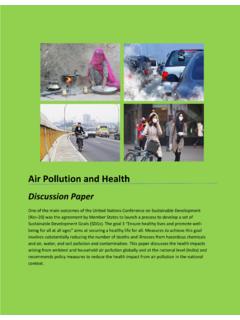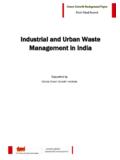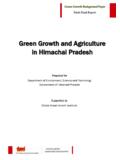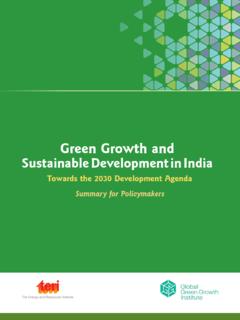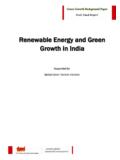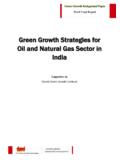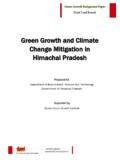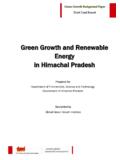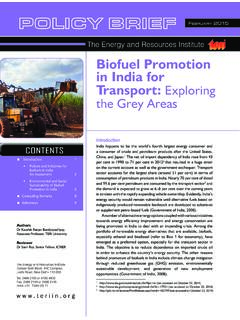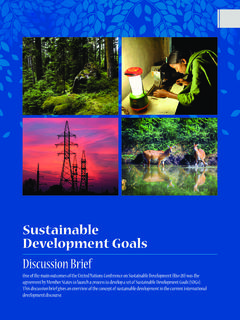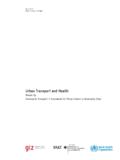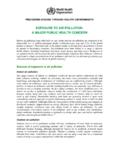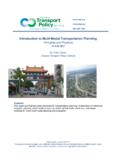Transcription of Green Growth and Transport in India - The Energy …
1 Draft Final Report Green Growth and Transport in India Supported by Global Green Growth Institute The Energy and Resources Institute 2015. Suggested format for citation T E R I. 2015. Green Growth and Transport in India . New Delhi: The Energy and Resources Institute. 37 pp. Author Seema Singh, Research Associate, TERI. Email: Reviewer Shri Prakash, Distinguish Fellow, TERI. Email: Akshima Tejas Ghate, Fellow, TERI. Email: For more information Project Monitoring Cell TERI Tel. 2468 2100 or 2468 2111. Darbari Seth Block E-mail IHC Complex, Lodhi Road Fax 2468 2144 or 2468 2145. New Delhi 110 003 Web India India +91 Delhi (0)11. Table of Content 1. Background .. 1. 2. Transport sector in India An overview .. 2. Railways .. 2. Rail 2. Passenger Transport .. 3. Freight Transport .. 4. Fuel consumption and emissions .. 5. Safety performance .. 6. Key issues .. 7. Roads .. 8. Road network .. 8. Vehicle Growth and composition.
2 9. Passenger Transport .. 10. Freight Transport .. 12. Fuel 12. Pollution .. 13. Road accidents and fatalities .. 13. Key issues .. 15. Civil aviation .. 16. Airport infrastructure and airlines .. 16. Traffic .. 16. Fuel 17. Key issues .. 17. Ports and Shipping .. 17. Infrastructure and traffic .. 17. Ports .. 17. Coastal Shipping .. 18. Inland waterways .. 18. Fuel 18. Key issues .. 19. Urban Transport .. 20. Modal shares .. 20. Fuel consumption and emissions .. 21. 22. Key issues .. 22. 3. Government structure and initiatives .. 22. Institutional Framework .. 22. Policies/Programmes/Plans .. 25. 4. Way forward .. 28. Develop integrated multi modal Transport systems .. 29. Promote shift to more Energy efficient and environment friendly modes .. 30. Shift from road Transport to railways and water Transport .. 30. Shift from personalized modes to public Transport and non-motorized Transport .
3 33. Improve Energy efficiency of the existing vehicle fleet .. 34. Plan a transition to cleaner 35. Integrated land use and Transport planning .. 35. Travel demand management (TDM) .. 35. Improve safety conditions .. 36. 5. References .. 37. List of Tables Table 1: Length of traction (in km) of railways by 3. Table 2: Type and length of different road categories in India (2014) .. 9. Table 3: A comparison of performance indicators of the STU's in 2013-14 and 2012-13 .. 11. Table 4: Institutions involved in planning and management of Transport services at different levels of governance in India .. 23. List of Figures Figure 1: Trend of originating passenger and passenger kilometer Growth in railways .. 4. Figure 2: Trends in total originating freight traffic and net freight tonne kilometers Growth in 5. Figure 3: Growth in consumption of electricity and HSD by railways for locomotive services.
4 6. Figure 4: Trend in incidence of accidents per million train kms .. 7. Figure 5: Causes of train accidents in 2013-14 .. 7. Figure 6: Growth in the total registered motor vehicles in India (1951-2012) .. 10. Figure 7: Growth in average bus fleet held and operated by STU's per year .. 11. Figure 8: Share of CO2 equivalent emissions from Transport sector in 2007 .. 13. Figure 9: Trends in total number of accidents and deaths in India (1970-2013) .. 14. Figure 10: Causes of road accidents in India in 2013 .. 15. Figure 11: Consumption of petroleum products in shipping in 2011-12 .. 19. Figure 12: Modal shares in Indian cities (percentage of daily trips) in 2007 .. 20. Figure 13: Top 25 polluted cities in India in terms of PM10 concentration levels (2012) .. 21. 1. Background Good Transport infrastructure is essential for socio-economic development of a country. India 's Transport network is vast and diverse comprising an extensive road network of 3,329,105 kilometers and 65,808 route kilometers of rail network geographically connecting the country along its length as well as breadth.
5 India also has an established aviation industry with international and domestic airline services currently being provided through 11 international airports and 89 domestic airports. India 's huge coastline of 7,517 km also provides significant opportunities for water based transportation services through a total of 12 major and 200 non major ports1 and 14,500 km of navigable inland waterways set up along the coastline. The Transport sector in India has grown extensively, especially post-independence, both in terms of physical spread as well as capacity to meet the mobility demands for both passengers as well as freight. Despite its impressive Growth , it is seen that the existing Transport infrastructure in India is far from meeting the growing mobility needs in terms of coverage, capacity as well as service quality. In fact, the current Transport Growth trajectory has brought along several negative externalities in terms of increasing congestion, increasing emissions and depleting air quality, rising health related risks, increase in deaths due to road accidents, increasing dependency on fossil fuels and an overall depleting quality of life.
6 The capacity for carrying freight traffic also falls short in view of rising demand and has resulted in increased logistics costs. In a developing country like India , these risks are further exacerbated in light of other development challenges such as rapid population Growth , inequality and poverty, high unemployment rate, lack of basic infrastructure facilities, poor access to services, etc. If the business as usual continues, the situation is further expected to worsen raising serious concerns for the country particularly in terms of national Energy security (in view of increasing dependence on oil imports). In view of the current Transport trajectory that has also brought along significant costs to society, economy as well as environment, a pressing need is felt for a paradigm shift from our present approach to a more sustainable development approach that promotes overall Green Growth '. of the Transport sector and a Green economy in the long run.
7 UNEP defines a Green economy as one that results in improved human well-being and social equity, while significantly reducing environmental risks and ecological scarcities. In its simplest expression, a Green economy can be thought of as one which is low carbon, resource efficient and socially inclusive (UNEP, 2011). In our endeavor to develop a future road map for Green Growth of the Transport sector in India , this chapter discusses in detail the key trends of the Transport sector in India , the key issues and challenges faced by the sector that limits its Growth and also makes recommendations to push the sector on a Green development path. 1 Major Ports are und er the ad ministrative control of Government of Ind ia w hile the N on -m ajor ports are governed by the respective Maritim e State Governm ents. 1. Green Growth and Transport in India 2. Transport sector in India An overview The Transport sector in India today faces an onerous task of meeting the mobility demands of a population of more than billion people spread over an area of million square kilometers (Census 2011).
8 For better understanding, the Transport sector can be divided into five major sub sectors namely railways, roads, ports and shipping, civil aviation and urban Transport . The trajectory in the Transport sector suggests the increasing dominance of the road sector in meeting the growing mobility demand with a gradual decline in the railway shares over the years. The next sections would discuss in detail the key trends in each of these sub-sectors and the issues faced by them that act as a hindrance to the overall Green Growth of the Transport sector. Railw ays Indian Railways (IR) is the fourth largest railway network in the world in terms of route kilometers (Twelfth Five Year Plan (2012-17), 2013). With a fleet size of 63,870 passenger service vehicles, 244,731 wagons, and 9956 locomotives, IR carries about 8421million originating passengers and of originating freight through 7547 stations (TEDDY , 2015).
9 Rail netw ork As on 31st March 2014, IR had a total network of 65,808 route kilometers2. About of the total rail network, equivalent to 21,618 route kilometers, is electrified. In terms of route density, Indian Railways stands at 20 route kilometers per 1000 sq. km of area and route km per lakh population (MoR 2015a). Considering that only 12,212 km of new lines have been added to the network since independence, the expansion of the rail network in the country has been slow in contrast to the rapidly increasing mobility needs in the country. As of March 2014, the total track length of the network is lakh kilometers3, of which percent of the total rail network is broad gauge (BG), followed by another metre gauge (MG) and percent narrow gauge (NG) (MoR 2015a). However, IR are now increasingly becoming uni-gauge by converting MG and NG to BG. Table 1 below gives the length of traction (in km) by gauge.
10 2 For d etails, please refer to http:/ / w w w .ind ianrailw railw ayboard / view =0,1,304,366,554,1554,1555. 3 For d etails, please refer to http:/ / w w w .ind ianrailw railw ayboard / view =0,1,304,366,554,1554,1555. 2. Green Growth and Transport in India Table 1: Length of traction (in km) of railw ays by gauge Gauge Route Kms. Running track Kms. Total Track Kms. Broad gau ge (1676 m m ) 58,177 81,914 1,07,513. Metre gau ge (1000 m m ) 5,334 5,708 6,688. N arrow gau ge (762 m m & 610 m m ) 2,297 2,297 2,564. Total 65,808 89,919 1,16,765. Source: MoR, 2015a IR is the topmost rail passenger carrier (in terms of passenger km) and the fourth largest rail freight carrier in the world (NTDPC, 2014). However, the traffic flows on the network are uneven and not balanced. As of March 2011, the BG network generated almost 98 percent of the passenger output (PKMs) and of the freight output (NTKMs). The Golden Quadrilateral and the diagonals connecting the four major metros, viz.
